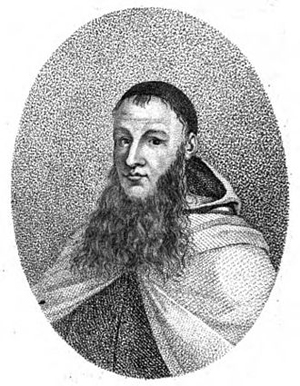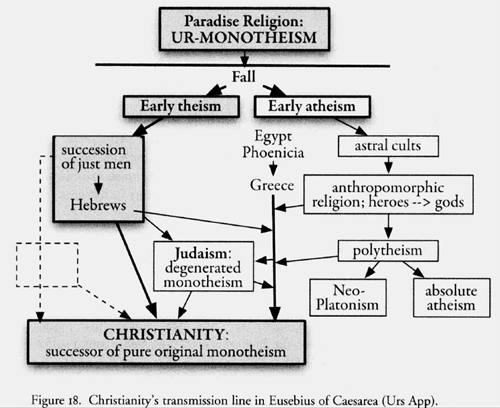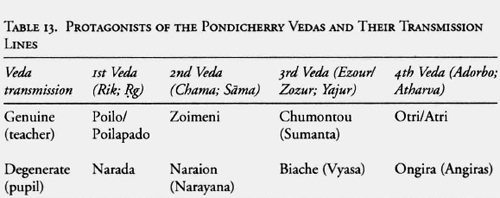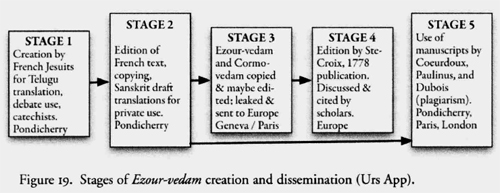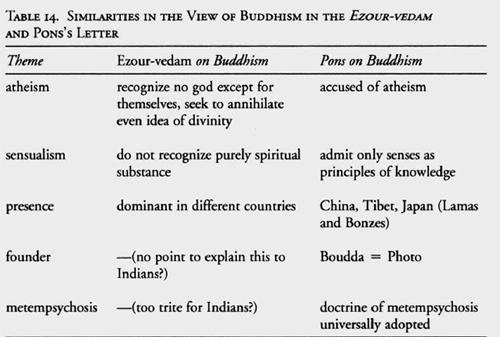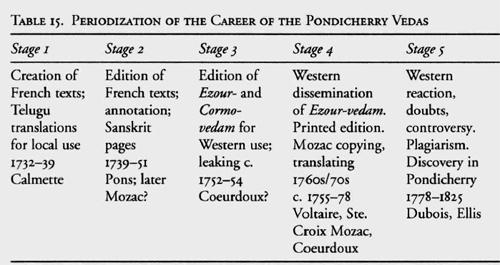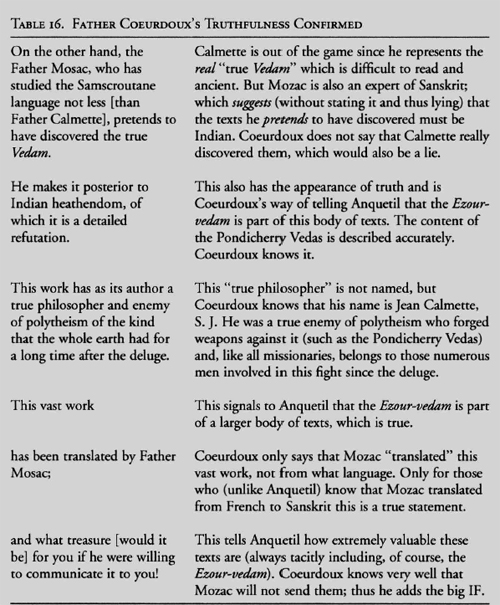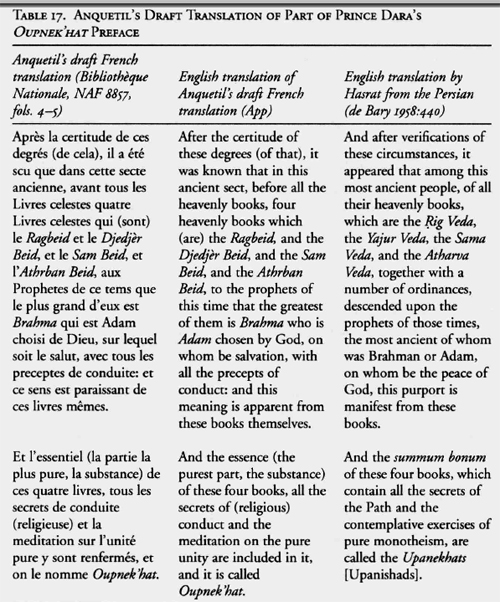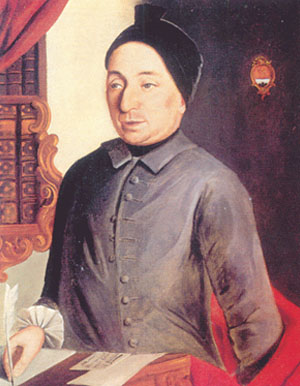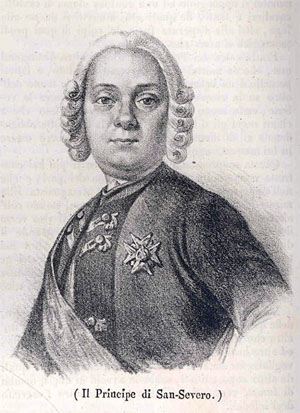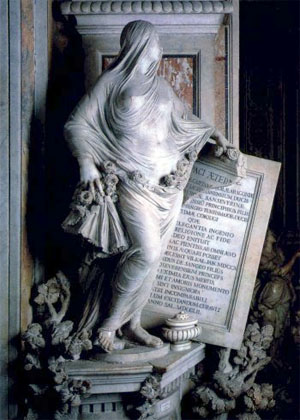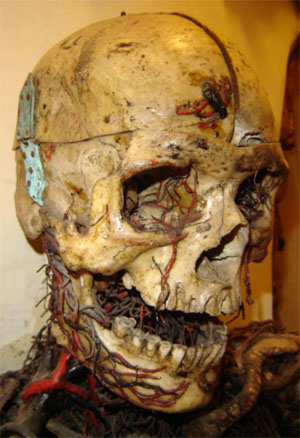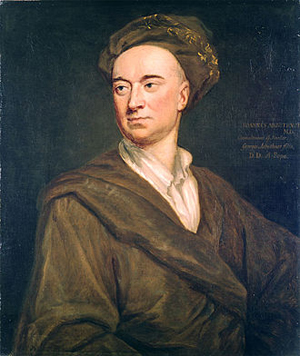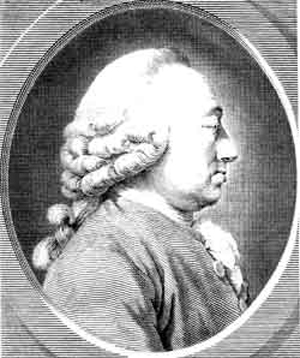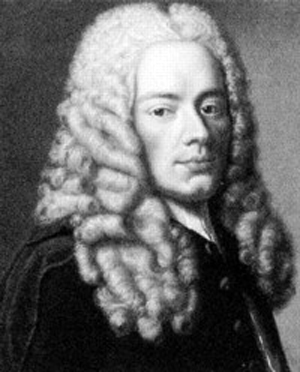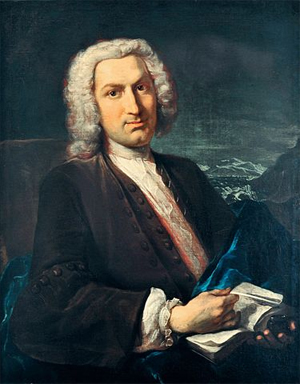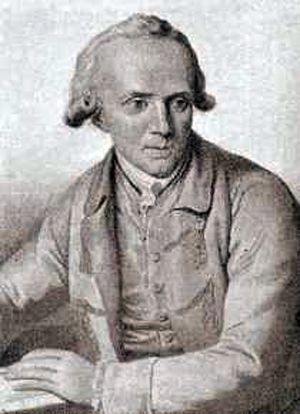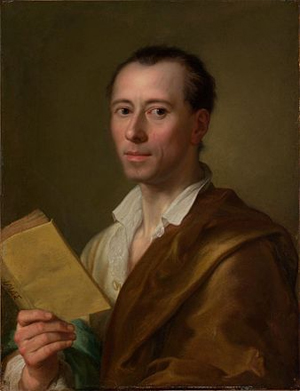Catalogs Rapid Search for "Vedas"
by National Library of France (Bibliotheque Nacional De France)
https://www.bnf.fr/fr
9/11/20
Librarian's Comment: Absence of Record to Prove Non-Existence of Catalog Item.
Father Jean Calmette's "copies of the four vedas" should be recorded as an entry into this catalog of works with a date of 1732-1735, when Calmette and Father Etienne Le Gac are said to have delivered the manuscripts, that Calmette opined would be unreadable. While the National Library of France gives notice that the index may not be exhaustive, the absence of a catalog entry for something that has been around to be catalogued for so long, and has been repeatedly cited by scholars as evidence of the existence of Veda transcripts on European soil during 18th century, would not be excusable. Accordingly, it seems likely that these Calmette/Le Gac vedas are among those that Father Paulinus a Sancto Bartholomaeo claims do not exist.
YOUR SEARCH: VEDAS 1045 RESULTS
105 pages
1 . Practical guide to Védasien / Saint-Jean-de-Védas / Saint-Jean-de-Védas town hall
Periodic
SUDOC: 1 BnF-CG: 1
1997?
2. The Citizen / Saint-Jean-de-Védas / Collective of Vedasian citizens
Periodic
SUDOC: 2 BnF-CG: 1
1999- [200.
3. Associative Life / St-Jean-de-Védas - Montpellier / [Town Hall] - S. Valade euro compo
Periodic
SUDOC: 1 BnF-CG: 1
1989-1996
4. Zysk Kenneth G. / Religious healing in the Veda / Philadelphia / American philosophical society
Delivered
SUDOC: 2 BnF-CG: 1
1985
5. The Vedas in Indian culture and history
Delivered
SUDOC: 1 BnF-CG: 1
6. Encyclopaedia of Indian heritage / New Delhi / Cosmo Publications
Delivered
SUDOC: 1
2002
7. Comparative studies in Merlin from the Vedas to CG Jung / Lewiston - Queenston - Lampeter / The Edwin Mellen Press
Delivered
SUDOC: 3 BnF-CG: 1
cop. 1991
8. Rigveda / Moskva / "Nauka
Delivered
SUDOC: 1 BnF-CG: 1
1999
9. The Vedas / Groningen / E. Forsten
10. Martinez Patrick / Saint-Jean-de-Védas
Delivered
SUDOC: 1 BnF-CG: 1
11. Hymns speculatives du Véda / [Paris] / Gallimard - UNESCO
Delivered
SUDOC: 18 BnF-CG: 1
DL 1985, I
12. Kuiper Franciscus Bernardus Jacobus / Aryans in the Rigveda / Amsterdam - Atlanta (Ga.) / Rodopi
Delivered
SUDOC: 4 BnF-CG: 1
1991
13. Remmer Ulla / Frauennamen im Rigveda und im Avesta / Wien / Verlag der Österreichischen Akademie der Wissensc
Delivered
SUDOC: 6 BnF-CG: 1
2006, cop.
14. Macdonell Arthur Anthony / Vedic index of names and subjects / Delhi / Motilal Bararsidass
Delivered
SUDOC: 1
1995
15. Wilden Eva / Der Kreislauf der Opfergaben im Veda / Stuttgart / F. Steiner
Delivered
SUDOC: 2 BnF-CG: 1
2000
16. 6 feet underground / Saint-Jean-de-Védas / 6 feet underground editions
Delivered
SUDOC: 3 BnF-CG: 1
impr. 2012
17. Jamison Stephanie W. / Function and form in the -áya- formations of the Rig Veda and Atharva Veda / Göttingen / Vandenhoeck und Ruprecht
Delivered
SUDOC: 3 BnF-CG: 1
cop. 1983
18. Oberlies Thomas / Der Rigveda und seine Religion / Berlin / Verlag der Weltreligionen
Delivered
SUDOC: 1 BnF-CG: 1
cop. 2012
19. Glück, Michaël / Brèves du Terral / Pézenas / Domens
Delivered
Heritage base: 1 SUDOC: 4 BnF-CG: 1
1997
20. Scarlata Salvatore / Die Wurzelkomposita im R̥g-Veda / Wiesbaden / Reichert
Delivered
SUDOC: 2 BnF-CG: 1
21. Rig-Veda - erster und zweiter Liederkreis
Delivered
SUDOC: 4 BnF-CG: 1
22. January, Ludovic / Brèves du Terral / Pézenas / Domens
Delivered
Heritage base: 1 SUDOC: 4 BnF-CG: 1
1998
23. Vraja Sundar das / Knowledge of the Vedas / Auxerre / Ed. des 3 monts
Delivered
SUDOC: 1 BnF-CG: 1
impr. 2010
24. Pinnacles of India's past / Amsterdam - Philadelphia / Benjamins
Delivered
SUDOC: 2 BnF-CG: 1
1986
25. Varenne Jean / Le Veda / Paris / The Two Oceans
Delivered
SUDOC: 13 BnF-CG: 1
1984
26. Jamison Stephanie W. / The "Rig Veda" between two worlds / Paris / Collège de France - Institut de civilization indi
Delivered
SUDOC: 10 BnF-CG: 1
2007
27. Feller Danielle / The Sanskrit epics' representation of Vedic myths / Delhi / Motilal Banarsidass
Delivered
SUDOC: 4 BnF-CG: 1
2004
28. Glimpses of Veda and vyakarana / Bombay / Popular Prakasha
Delivered
SUDOC: 1 BnF-CG: 1
1985
29. Schmeja Hans / Interpretationen aus dem Rigveda / Innsbruck / Institut für Sprachwissenschaft der Universität
Delivered
SUDOC: 1 BnF-CG: 1
1987
30. Martinez Patrick / 31 names in gold letters / [Saint-Jean-de-Védas] / [P. Martinez]
Delivered
SUDOC: 1 BnF-CG: 1
impr. 2011
31. Bianu Zéno / A fire in the heart of the wind
Delivered
SUDOC: 5 BnF-CG: 1
32. Aguilar i Matas Enric / R̥gvedic society / Leiden, The Netherlands - New York / EJ Brill
Delivered
SUDOC: 1 BnF-CG: 1
1990
33. Niederreiter Stefan / Morphologische Varianz und semantische Konkurrenz / Graz / Leykam
Delivered
SUDOC: 1 BnF-CG: 1
2001
34. Vedic Cosmogonies / Paris - Milano / The Beautiful Letters - Arche
Delivered
SUDOC: 11 BnF-CG: 1
1982
35. Rigveda / Moskva / "Nauka
Delivered
SUDOC: 1 BnF-CG: 1
1995
36. Bādarāyaṇa / Brahmasūtraśāṅkarabhāṣyam / Dillī / Nāga Prakāśakah̤
Delivered
SUDOC: 2
2000
37. Stories to scratch your head / Castelnau-le-Lez / Southern Publishing Company
Delivered
SUDOC: 1 BnF-CG: 1
impr. 1992
38. Richter-Ushanas Egbert / The Indus script and the Ṛg-Veda / Delhi / Motilal Banarsidass Publishers
Delivered
SUDOC: 4 BnF-CG: 1
impr. 1997
39. Gonda Jan / The medium in the Rgveda
Delivered
SUDOC: 6 BnF-CG: 1
40. Martinez Patrick / Saint-Jean-de-Vedas / [Saint-Jean-de-Vedas] / P. Martinez
Delivered
SUDOC: 2 BnF-CG: 1
41. Göhler Lars / Reflexion und Ritual in der Purvamimamsa / Wiesbaden / Harrassowitz
Delivered
SUDOC: 2 BnF-CG: 1
2011
42. Pirart Eric / Les Nāsatya / Liège - Geneva / Library of the Faculty of Philosophy and Let
Delivered
SUDOC: 11
1995, cop.
43. Montpellier
Menu
BnF-CG: 1
44. [Hotel Palestine, play by Falk Richter] / Paris
Manuscript
BnF-CG: 1
2011
45. [Hotel Palestine, play by Falk Richter. Studio Casanova, Ivry-sur-Seine]
Manuscript
BnF-CG: 1
2011
46. Benedetto André / Here begins lunchtime - Last cigarettes / Avignon / Théâtre des Carmes
Manuscript
BnF-CG: 1
1989
47. [The precious ridiculous, directed by Yves Gourmelon]
Manuscript
BnF-CG: 1
2005
48. [First love, Yves Gourmelon design]
Manuscript
BnF-CG: 1
2005
49. Minutes of the election of Auguste Cambon (father of the conventional) as secretary-clerk of I
Manuscript
Heritage base: 1
18
50. Saumade, Gratien / Collection of documents to be used in the history of the anarchic municipal administration of the canton of
Manuscript
Heritage base: 1
51. [Collection. Le Chai du Terral, Saint-Jean-de-Védas] / Paris
Manuscript
BnF-CG: 1
1994
52. [Collection. Le Chai du Terral, Saint-Jean-de-Védas, 2014-2015. Programming documents]
Manuscript
BnF-CG: 1
2014-2015
53. [Collection. Le Chai du Terral, Saint-Jean-de-Védas, 2016-2017. Programming documents]
Manuscript
BnF-CG: 1
2016-2017
54. [Collection. Le Chai du Terral, Saint-Jean-de-Védas, 2017-2018. Programming documents]
Manuscript
BnF-CG: 1
2017-2018
55. [An evening with friends, designed by Yves Gourmelon]
Manuscript
BnF-CG: 1
2005
56. Actors / Saint-Jean-de-Védas / Free Midi Group
Periodic
BnF-CG: 1
1996- [199.
57. Arthropode / Saint-Jean-de-Védas - Montpellier / 6 feet underground ed. - 6 feet under edit
Periodic
BnF-CG: 0
impr. 2009
58. [Municipal bulletin] / Saint-Jean-de-Védas / Town hall
Periodic
BnF-CG: 1
19 ?? -
59. Theatrical field / Saint-Jean-de-Védas - Vic-la-Guardiole - Paris / l'Entretemps ed. - l'Entretemps ed. - Entreemps
Periodic
BnF-CG: 0
2002- - 20
60. Cnews morning Montpellier plus / Saint-Jean-de-Védas / Société du journal Midi libre
Periodic
BnF-CG: 1
61. Cnews Montpellier plus / Saint-Jean-de-Védas / Midi libre newspaper company
Periodic
BnF-CG: 1
2017-2019
62. White collection / Montpellier - Frontignan - Saint-Jean-de-Védas / 6 pieds sous terre éd. - 6 feet underground - 6 ft
Periodic
BnF-CG: 0
1996- - 20
63. Collection Les Beaux sites / Saint-Jean-de-Védas
Periodic
BnF-CG: 0
64. Direct morning Montpellier plus / Saint-Jean-de-Védas / Montpellier Plus
Periodic
BnF-CG: 1
2012-2017
65. Direct Montpellier plus / Saint-Jean-de-Védas / SPGM
Periodic
BnF-CG: 1
2009-2011
66. In Var country / Draguignan - Saint-Jean-de-Védas / Agricultural Publishing of Var - SA Paysan du Midi
Periodic
BnF-CG: 1
1973- - 20
67. Jade / Pignan / 6 feet underground
Periodic
SUDOC: 5
1991- [199.
68. [The Egg] / Saint-Jean-de-Vedas / COMEDI
Periodic
BnF-CG: 1
1986-1989
69. The Sacred Science of the Vedas / Perpignan / Editions Ananda Marga-The Way of Bliss
Periodic
BnF-CG: 0
[20..] -
70. The Years Free Midi / Saint-Jean-de-Védas / Free Midi
Periodic
BnF-CG: 1
1994
71. [The Atlas of ACOMEN] / Saint-Jean-de-Vedas / Concerted action group in nuclear medicine of
Periodic
BnF-CG: 0
72. The Séranne notebooks / Le Vigan [then] Saint-Jean-de-Védas / The Séranne notebooks
Periodic
BnF-CG: 0
1992
73. Gourmet lunch / Saint-Jean-de-Védas / Free lunch
Periodic
BnF-CG: 1
2010
74. Monotrème / Montpellier - Frontignan - Saint-Jean-de-Védas / 6 feet underground ed. - 6 feet underground - 6 ft
Periodic
BnF-CG: 0
1997- 20
75. Monotrème mini / Frontignan - Saint-Jean-de-Védas / 6 feet underground - 6 feet underground
Periodic
BnF-CG: 0
2006- - 20
76. Montpellier Hérault synergy / Montpellier / SEDIP Communication
Periodic
BnF-CG: 1
[199.] - [19
77. Montpellier plus / Saint-Jean-de-Védas / SPGM-Society for free publications in the Midi
Periodic
BnF-CG: 1
2005-2009
78. Montpellier plus / Saint-Jean-de-Védas / SPGM-Society for free publications in the Midi
Periodic
BnF-CG: 1
2011-2012
79. Occitans at Clapàs! / St-Joan-de-Vedas [Saint-Jean-de-Védas] / Occitan Ceucle de Montpelhièr
Periodic
BnF-CG: 0
198? -198?
80. Quo vadis? / Saint John of Védas / Quo vadis? C / o Jean-Pierre Almignan
Periodic
BnF-CG: 1
1992-
81. Resources Free Midi / Saint-Jean-de-Védas / Free Midi
Periodic
BnF-CG: 1
1994-
82. Free time / Saint-Jean-de-Védas / Free time
Periodic
BnF-CG: 1
[ca 1991] -
83. Land of wines / Saint-Jean-de-Védas / Ed. Midi periodicals
Periodic
BnF-CG: 1
[201.] -
84. Achieve everything from home to garden / Saint-Jean-de-Vedas - Saint-Cloud / Midi libre - HB publications
Periodic
BnF-CG: 1
2005
85. Yudansha / Saint-Jean-de-Védas / J.-J. Quero Martial Arts Academy
Periodic
BnF-CG: 1
1995-1997
86. Fabcaro / - 20% on the spirit of the forest / Saint-Jean-de-Védas / 6 feet underground
Delivered
BnF-CG: 1
impr. 2011
87. James / 365 times 77.8 / Saint-Jean-de-Védas / 6 feet underground ed. Delivered
BnF-CG: 1
impr. 2012
88. Cousinié Jean-Pierre / 500 new ideas to understand and apply the Cousinié / Narbonne / Cousinié method
Delivered
BnF-CG: 1
[2011]
89. 6 feet underground (Saint-Jean de Védas, Hérault) / 6 feet underground, the animal is twenty years old / Montpellier / 6 feet underground
Delivered
Heritage base: 1
2011
90. Schmidt Peter / AC Bhaktivedanta Swami im interreligiösen Dialog / Frankfurt am Main - New York / P. Lang
Delivered
SUDOC: 1
91. Galewicz Cezary / A commentator in service of the empire / Wien / Sammlung de Nobili, Institut für Südasien-, Tibe
Delivered
SUDOC: 2
2009
92. Dvivedī Kapiladeva / A cultural study of the Atharvaveda / Gyanpur, India / Vishvabharati Research Institute
Delivered
SUDOC: 1
1999
93. A descriptive catalog of Sanskrit manuscripts in the Government oriental library, Mysore / Mysore / the Asst. Supdt., Govt. branch press
Delivered
BnF-CG: 1
1937
94. Subrahmanya Sastri Palamadai Pichumani / A Descriptive catalog of the Sanskrit manuscripts in the Tanjore Maharaja Serfoji's Sarasvati Maha / Srirangam / Sri Vani Villas Press
Delivered
BnF-CG: 1
1928-1975
95. Sen Chitrabhanu / A dictionary of the Vedic rituals / Delhi / Concept Pub. Co. Delivered
SUDOC: 4
impr. 1978
96. Kulkarni Nirmala Ravindra / A grammatical analysis of the Taittirīya-padapāṭha / Delhi / Sri Satguru Publications
Delivered
SUDOC: 1
impr. 1995
97. A grammatical word-index to R̥gveda / Hoshiarpur / VVRI
Delivered
BnF-CG: 1
1963
98. Dasgupta Surendranath / A history of Indian philosophy / Delhi / Motilal Banarsidass
Delivered
SUDOC: 2
1975
99. Coomaraswamy Ananda Kentish / A new approach to the Vedas / New Delhi / Munshiram Manoharlal publ. Delivered
BnF-CG: 1
1994
100. Nicoby / In Ouessant / Saint-Jean-de-Védas / 6 feet underground
Delivered
BnF-CG: 1
impr. 2010
101. Vasiṣṭha / A Pargiánya, ínno di Vásist̡a / Bològna / Règia tipografía
Delivered
BnF-CG: 1
1892
102. Lubotsky Alexander Markovitsj / A Ṛgvedic word concordance / New Haven (Conn.) / American Oriental Society
Delivered
SUDOC: 2
1997
103. A second selection of hymns from the Rigveda / Bombay / Government central book depot - Department of publ
Delivered
BnF-CG: 1
1899
104. Gupta Shanti Swarup / A study of deities of Rig Veda / New Delhi / Abhinav Publications
Delivered
SUDOC: 1
2006
105. Barre Armand / Through the millennia / [Saint-Jean-de-Védas] / A. Barre
Delivered
BnF-CG: 0
2001-
106. Bloomfield Mauritius / A Vedic concordance / Delhi / Motilal Banarsidass
Delivered
BnF-CG: 1
1990
107. Macdonell Arthur Anthony / A vedic reader for students / Oxford / University Press
Delivered
SUDOC: 3
nineteen eighty one
108. Macdonell Arthur Anthony / A Vedic reader for students / Delhi / M. Banarsidass
Delivered
SUDOC: 4
1992
109. Sahoo Purna Chandra / Abhicāra rites in the Veda / Delhi / Pratibha Prakashan
Delivered
SUDOC: 1
2009
110. Dvivedī Kapiladeva / Ācāra-śikṣā - आचार-शिक्षा / Vārāṇasī - वाराणसी / Viśvabhāratī Anusandhāna Pariṣad - विश्वभारती
Delivered
BnF-CG: 1
san 1984 i
111. Rambachan Anantanand / Accomplishing the accomplished / Honolulu (TH) / University of Hawaii press
Delivered
BnF-CG: 1
cop. 1991
112. Ellis Francis / Account of a discovery of a modern imitation of the Vedas with remarks on the genuine works / [S. l. ?]
Delivered
BnF-CG: 1
[1822?]
113. Lauriol, Jean-Luc / Agence Laurion (Montpellier) / Montpellier / Agence Lauriol
Delivered
Heritage base: 1
2004
114. Kaṃsārā Nārāyaṇa Ma / Agriculture and animal husbandry in the Vedas / Delhi / Dharam Hinduja International Center of Indic Resea
Delivered
SUDOC: 1
1995
115. Ayengar Viswanath KN / An attempt at the revivale of the Vedas in terms of modern science / [S. l. ?]
Delivered
BnF-CG: 1
[nineteen eighty one?]
116. Bartley Christopher J. / An introduction to Indian philosophy / London - New York / Bloomsbury Academic
Delivered
SUDOC: 1
2015
117. Bloomfield Maurice / An updated Vedic concordance / Cambridge (Mass.) - Milan / Department of Sanskrit and Indian studies, Harvard
Delivered
BnF-CG: 1
2007
118. Franceschini Marco / An updated Vedic concordance / Cambridge, MA - Milan / Dept. of Sanskrit and Indian Studies, Harvard Univ
Delivered
SUDOC: 1
2007
119. Madhva / Ānandatīrthabhagavatpādācārya viracitam R̥gbhāṣyam / Bangalore / Dvaita Vedanta Studies and Research Foundation
Delivered
SUDOC: 1
1999-
120. Anirvan / Anirvan's Veda-mīmāṁsā / Shimla / Indian Institute of Advanced Study
Delivered
SUDOC: 1
2004-
121. Āpastamba / Āpastamba śraddha prayogaḥ
Delivered
SUDOC: 1
122. Āpastamba / Āpastambīyapūrvāparaprayogaḥ
Delivered
SUDOC: 1
123. Khanna Dev Raj / Aquatic science in the Vedas / New Delhi / Biotech Books
Delivered
SUDOC: 1
2014
124. Arrest of the Council of State of Roy, of October 6, 1722, which breaks a sentence of the General Visitors of / Paris / impr. de la Vve and M.-C. Jouvenal
Delivered
Heritage base: 1
1722
125. Arrest of the Council of State of Roy, of October 6, 1722, which overturns a sentence of the General Visitors of / Paris / Vve & M.-G. Jouvenel
Delivered
Heritage base: 1
1722
126. Arrest of the Council of State of Roy, which breaks a sentence of the general visitors of the gabelles of Langu / Paris / impr. by Vve Saugrain and - P. Prault
Delivered
BnF-CG: 1
1732
127. Judgment of the Council of State which overturns a sentence of the general visitors of the Languedoc gabelles in Mo / Paris / imp. by Jouvenel
Delivered
BnF-CG: 1
1722
128. Judgment of the Council of State which overturns a sentence of the general visitors of the Languedoc gabelles in Mo / Paris / imp. by Jouvenel
Delivered
BnF-CG: 1
1722
129. Dange Sindhu Sadashiv / Aspects of speech in Vedic ritual / New Delhi / Aryan Books International
Delivered
SUDOC: 1
1996
130. Āśvalāyana / Āśvalāyana śraddha prayogaḥ
Delivered
SUDOC: 1
131. Āśvalāyana / Āśvalāyanapūrvāparaprayōgaḥ
Delivered
SUDOC: 1
132. Jhala Gowriprasad Chunilal / Aśvinā in the Rgveda and other indological essays / Bombay - New Delhi / GC Jhala Memorial Committee - sole distributors,
Delivered
SUDOC: 1
1978
133. Atha Gāyatrī pañcaṅga-prārambhaḥ / Bambaī [Mumbai] / Khemarāja Śrīkr̥ṣṇadāsa, Śrīvenkaṭeśvara
Delivered
SUDOC: 1
1986
134. Atharva-Veda saṃhitā
Delivered
SUDOC: 2
135. Atharva-veda Saṁhitā / Delhi / Nag
Delivered
SUDOC: 1
1987
136. Ātharvaṇā / Kolkata / Sanskrit Book Depot
Delivered
SUDOC: 1
2002
137. Zehnder Thomas / Atharvaveda-Paippalāda Buch 2, Text, Übersetzung, Kommentar / Idstein / Schulz-Kirchner
Delivered
BnF-CG: 1
1999
138. Atharvavedavaiyakarana-padasuci / Hoshiarpur / VVRI
Delivered
BnF-CG: 1
1963
139. Lacroix Samuel / Audit of the DECATHLON cycle department, St Jean de Vedas / Montpellier / University of Montpellier 2 Sciences and Technology
Delivered
SUDOC: 1
2002
140. Authority, anxiety, and canon / Albany / State University of New York Press
Delivered
SUDOC: 3
141. Domergue René / Avise, the organic! / Montpezat / R. Domergue
Delivered
BnF-CG: 1
impr. 2008
142. Nigal Sahebrao Genu / Axiological approach to the Vedas / New Delhi / Northern book center
Delivered
BnF-CG: 1
1986
143. Caudhurī Sādhana Kamala / Beda o Buddha / Kalakātā / Karuṇā Prakās̓anī
Delivered
SUDOC: 1
2000
144. Hertel Johannes / Beiträge zur Erklärung des Awestas und des Vedas, von Johannes Hertel / Leipzig, S. Hirzel
Delivered
BnF-CG: 1
1929. Gr.
145. Quet Dominique André / Shepherd in the four seasons / Saint-Jean-de-Védas / PHOTOBIM
Delivered
BnF-CG: 1
2007
146. Roy Ramashray / Beyond ego's domain / Delhi / Shipra Publications
Delivered
SUDOC: 1
1999
147. Bhattacharyya Narendra Nath / Bhārata-itihāse baidika yuga / Kalakātā / Bedabidyākendra, Rabīndrabhāratī Bisvabidyāla
Delivered
SUDOC: 1
1998
148. Murthy SRN / Bhārathīya bhū-tattwa-rahasyam / Bangalore / Kalpatharu Research Academy
Delivered
SUDOC: 1
impr. 1994
149. Evolutionary library / Paris / A. Maloine
Delivered
BnF-CG: 1
1919-
150. Libraries manual / [Sète] / Agence de cooperation pour le livre en Languedoc-R
Delivered
BnF-CG: 1
1997
151. Nagar Shanti Lal / Biographical dictionary of ancient Indian Ṛṣis / New Delhi / Akshaya Prakashan
Delivered
SUDOC: 1
2012
152. Baudhāyana / Bodhāyanapūrvāparaprayōgaḥ
Delivered
SUDOC: 1
153. Bali Saraswati / Bṛhaspati in the Vedas and the Purāṇas / Delhi / Nag Publishers
Delivered
SUDOC: 2
1978
154. Patton Laurie L. / Bringing the gods to mind
Delivered
SUDOC: 5
155. Bouchart d'Orval Jean / Burning clarity / Paris / Almora editions
Delivered
BnF-CG: 1
DL 2016
156. Chevrou Robert / Corpses in the forest / Saint-Jean-de-Védas / RB Chevrou
Delivered
BnF-CG: 1
2002
157. Fernhout Rein / Canonical texts / Amsterdam - Atlanta, Ga. / Rodopi
Delivered
SUDOC: 2
1994
158. Blaine Julien / Character for the one who flames / Saint-Jean-de-Védas / Les Cahiers de la Séranne
Delivered
BnF-CG: 1
1994
159. Demangeot Cédric / & cargaisons / Montpellier / Éd. Greige
Delivered
BnF-CG: 1
2004
160. Quet Dominique André / Dominique André Quet's report card / Saint-Jean-de-Védas / PHOTOBIM
Delivered
BnF-CG: 0
2007-
161. Beguin Coralie / Carrefour Saint-Jean-de-Védas / [Sl] / [sn]
Delivered
SUDOC: 1
1999
162. Śarmā Muṃśirāma / Caturveda mīmāṃsā / Naī Dillī / Yūnivarsiṭī Pablikeśansa
Delivered
BnF-CG: 1
1999
163. Caturveda-vaiyākaraṇa-padasūcī / Hośiārapuram (Bharata) / Viśveśvarānanda-Vaidika-Śodha Saṃsthānam
Delivered
BnF-CG: 1
1960-1963
164. Terral cellar / Saint-Jean-de-Védas / Terral cellar
Delivered
SUDOC: 1
1995
165. Madhva / Chāndogyopaniṣadbhāsyam / Bangalore / Poornaprajna samshodhana mandiram
Delivered
SUDOC: 1
2004
166. Sparreboom M. / Chariots in the Veda / Leiden / EJ Brill
Delivered
SUDOC: 2
1985
167. Sparreboom Marcus / Chariots in the Veda / [Netherlands] / M. Sparreboom
Delivered
SUDOC: 3 BnF-CG: 1
1983
168. Soto Fernández Ramón / Clave de las mitologías, 2a época. Cuaderno 6. El Brahmanismo y el Buddhismo. Las Puranas. Los Vedas / Madrid
Delivered
BnF-CG: 1
1954. In-8
169. Collection of the Upanichats, extracts from the Vedas / [Sl] / [sn]
Delivered
Heritage base: 1
1837
170. Collection of Oupanichats extracted from the Védas trad. from Sanskrit by L. Poley / Paris
Delivered
Heritage base: 1
Delivered
SUDOC: 4 BnF-CG: 1
2004
171. Poley, Ludovicus / Collection des Oupanichats, extracts from the Védas, translated from Sanskrit / Paris / Dondey-Dupré and Arthus Bertrand
Delivered
Heritage base: 1
1836
172. James / Like a Monday / Saint-Jean-de-Védas / 6 feet underground ed. Delivered
BnF-CG: 1
impr. 2009
173. Plateau Émilie / Comme un plateau / Saint-Jean-de-Védas / 6 pieds sous terre éd. Delivered
BnF-CG: 1
impr. 2012
174. How to discriminate the spectator of the show? / Paris / J. Maisonneuve
Delivered
SUDOC: 3
1977
175. Chinmoy Sri / Commentaries on the Vedas, the Upanishads and the Bhagavad Gita / Jamaica, NY / Aum Publications
Delivered
SUDOC: 1
c1966
176. Chakraborty Chhanda / Common life in the Ṛgveda and Atharvaveda / Calcutta / Punthi Pustak
Delivered
SUDOC: 1
1977
177. Mueller Christoph / Tales of a man of taste / Saint-Jean-de-Védas / 6 feet underground
Delivered
BnF-CG: 1
impr. 2012
178. Tyagi Jaya / Contestation and compliance / New Delhi / Oxford university press
Delivered
BnF-CG: 1
cop. 2014
179. Tyagi Jayanti / Contestation and compliance / New Delhi / Oxford University Press
Delivered
SUDOC: 3
cop. 2014
180. Rāghavan Veṅkaṭarāma / Contribution of Tamilnadu to Sanskrit: Vedas, Śāstras, Kāvyas, etc / [S. l. ?]
Delivered
BnF-CG: 1
181. Malamoud Charles / Cooking the world / Delhi - New York / Oxford University Press
Delivered
SUDOC: 3
1996
182. Varenne Jean / Vedic cosmogonies / [Sl] / [sn]
Thesis
SUDOC: 1
1979
183. Adolphe Jean-Marc / Crisis of representation / Saint-Jean-de-Védas / Entretemps ed. Delivered
BnF-CG: 1
2003
184. Malamoud Charles / Bake the world
Delivered
SUDOC: 59
185. Sharma Rajendra Nath / Culture & civilization as revealed in the Śrautasūtras / Delhi / Nag Publishers
Delivered
SUDOC: 2
1977
186. Singh Satya Prakash / Dadhyaṅ Ātharvaṇa / New Delhi / Standard publishers (India)
Delivered
BnF-CG: 1
2013
187. Dal X libro del Ṛg-Veda / Pisa / Giardini
Delivered
BnF-CG: 1
nineteen eighty one
188. Duba Pierre / In my paper house / Saint-Jean-de-Védas / 6 pieds sous terre éd. Delivered
BnF-CG: 1
impr. 2014
189. Mylius Klaus / Das Altindische Opfer / Wichtrach / Institut für Indologie
Delivered
SUDOC: 2
2000
190. Labernadie Victor / On the antiquity of leprosy according to the Vedas... / Paris, Masson
Delivered
BnF-CG: 1
(nd) In
191. Plateau Émilie / On the other side, in Montreal / Saint-Jean-de-Védas / 6 pieds sous terre éditions
Delivered
BnF-CG: 1
impr. 2014
192. Masset Pierre / Of remembrance and friendship / [Saint-Jean de Védas] / "Quo vadis"
Delivered
BnF-CG: 1
1996
193. Dumézil Georges / Latin goddesses and Vedic myths / New York / Arno press
Delivered
SUDOC: 1
1978
194. Mukhopadhyay Samir Kumar / Deities in the R̥gvedic Brāhmanas / Kolkata / Sanskrit Book Depot
Delivered
SUDOC: 1
2003
195. Gädicke Carl / Der Accusativ im Veda, dargestellt von Carl Gaedicke,... / Breslau / W. Koebner
Delivered
BnF-CG: 1
1880
196. Sartorius Joachim / Shadows under the waves / Montpellier / Ed. Greige
Delivered
BnF-CG: 1
impr. 2005
197. Barthélemy-Saint-Hilaire, Jules / Des Védas / Paris / B. Duprat
Delivered
Heritage base: 3 BnF-CG: 1
1854
198. Desnoyer, 1894-1972 / Nîmes / Art gallery
Delivered
BnF-CG: 1
1996
199. Vader VH / Determination of the vernal equinox in the constellations Punarvasu, Puṣya, Aśleṣā, etc., or furth / [S. l. ?]
Delivered
BnF-CG: 1
[1926?]
200. Devotional Agni-Hymns from Rigveda / Poona / Bharatiya Charitrakosha Mandal's PJ Chinmulgund
Delivered
SUDOC: 1
[1990]
201. Dharma and Vedic foundations / Bombay / Shri Bhagavan Vedavyasa Itihasa Samshodhana Mandir
Delivered
SUDOC: 1
1995
202. Kuznetsova Irina / Dharma in ancient Indian thought
Delivered
SUDOC: 1
203. Sudres Claude / International Cycling Dictionary 2004 / [Saint-Jean-de-Vedas] / [C. Sudres]
Delivered
BnF-CG: 1
2004
204. Miyakawa Hisashi / Die altindischen Grundzahlwörter im Rigveda / Dettelbach / Röll, JH
Delivered
SUDOC: 3
cop. 2003
205. Kupfer Katharina / Die Demonstrativpronomina im Rigveda / Frankfurt am Main - New York / Lang
Delivered
SUDOC: 1
cop. 2002
206. Richter-Ushanas Egbert / Die Dialog-Hymnen des Rg-Veda / Worpswede / Richter
Delivered
BnF-CG: 1
2005
207. Richter-Ushanas Egbert / Die Dreigestalt des Seins und der androgyne kosmische Mensch / Bremen / Richter
Delivered
BnF-CG: 1
2005
208. Die Hymnen des Rigveda / Berlin
Delivered
BnF-CG: 1
1851-1863
209. Die Hymnen des Rigveda / Bonn
Delivered
BnF-CG: 1
1877. 2nd
210. Die Hymnen des Rigveda / Wiesbaden / Otto Harrassowitz
Delivered
BnF-CG: 1
1955
211. Mayrhofer Manfred / Die Personennamen in der Rgveda-Samhita. Sicheres und Zweifelhaftes / München / Bayerische Akademie der Wissenschaften
Delivered
SUDOC: 4
2003
212. Mayrhofer Manfred / Die Personennamen in der Ṛgveda-Saṁhitā / München / Verlag der Bayerischen Akademie der Wissenschaften
Delivered
BnF-CG: 1
cop. 2003
213. Oberlies Thomas / Die Religion des R̥gveda / Wien / Inst. für Indologie der Universität Wien
Delivered
SUDOC: 3
1998
214. Oberlies Thomas / Die Religion des rgveda / Wien / Institut für Indologie der Universität Wien
Delivered
SUDOC: 1
cop. 1999
215. Oldenberg Hermann / Die Religion des Veda / Berlin / Besser
Delivered
BnF-CG: 1
1894
216. Oldenberg Hermann / Die Religion des Veda / Stuttgart - Berlin / JG Cotta
Delivered
BnF-CG: 1
1917
217. Richter-Ushanas Egbert / Die Symbolik der Indus-Schrift im Vergleich zum Rg-Veda / Bremen / E. Richter
Delivered
BnF-CG: 1
2002
218. Rau Wilhelm / Die vedischen Zitate im Vyākaraṇa-Mahābhāṣya / Mainz - Stuttgart / Akademie der Wissenschaften und der Literatur - F. Delivered
BnF-CG: 1
1985
219. Rau Wilhelm / Die vedischen Zitate in der Kāśikā Vṛtti / Mainz - Stuttgart / Akademie der Wissenschaften und der Literatur - F. Delivered
SUDOC: 7
1993
220. Zeller Gabriele / Die vedischen Zwillingsgötter
Delivered
SUDOC: 1
221. Klaus Konrad / Die wasserfahrzeuge im vedischen Indien / Mainz - Stuttgart / Akademie der Wissenschaften und der Literatur - F. Delivered
SUDOC: 6
1990
222. Harvest Patrick / Magician gods in the Rgvedasamhita / [Sl] / [sn]
Thesis
SUDOC: 1
1990
223. Doumergue Jean-Louis / Diffuser of love / Béziers / Association Amour essence
Delivered
BnF-CG: 1
impr. 2007
224. Bary / Speech delivered / (Montpellier / Tournel
Delivered
Heritage base: 1
1791
225. Valat, Etienne / Speech delivered at the tomb of C. Chapel in Saint-Jean-de-Védas / Montpellier / Impr. southern
Delivered
Heritage base: 1
1894
226. Staal Frits / Discovering the Vedas / New Delhi - New York / Penguin Books
Delivered
SUDOC: 2
2008
227. Dange Sadashiv Ambadas / Divine hymns and ancient thought / New Delhi / Navrang
Delivered
SUDOC: 1
1992
228. Auvard Alfred / Doctor A. Auvard. Evolutionary doctrine, science of the Vedas. Theosophy, evolution... / Paris, A. Maloine et fils
Delivered
BnF-CG: 1
(nd). I
229. Auvard, A. / Doctor A. Auvard. Evolutionary doctrine, science of the Vedas. Theosophy, evolution... / Paris, A. Maloine et fils
Delivered
Heritage base: 2
2209
230. Auvard, A / Evolutionary doctrine / Paris / A. Maloine
Delivered
Heritage base: 1
1920
231. Auvard, A. / Evolutionary doctrine; science of vedas / Paris / Maloine
Delivered
Heritage base: 1
1920
232. Auvard, A. / Evolutionary doctrine. (Science of the Vedas). Théosophie Evoluisme / Paris / A. Maloine et fils
Delivered
Heritage base: 1
1920
233. Auvard, Alfred / Evolutionary doctrine, science of the Vedas, theosophy, evolution / Paris / Maloine
Delivered
Heritage base: 1
1920
234. Auvard, A. / Evolutionary doctrine (science of the Vedas) / Paris / A. Maloine et fils
Delivered
Heritage base: 1
1920
235. Auvard, Alfred / Evolutionary doctrine / Paris / A. Maloine
Delivered
Heritage base: 1
1920
236. Sarkar Anil Kumar / Dynamic facets of Indian thought / New Delhi / Manohar
Delivered
SUDOC: 1
1980
237. Sarkar Anil Kumar / Dynamic facets of Indian thought / New Delhi / Manohar
Delivered
BnF-CG: 1
1980
238. Ecclesia Divina, or, A selection of hymns from the four Vedas / New Delhi / Kaveri Books
Delivered
SUDOC: 1
2002
239. Vannucci Marta / Ecological readings in the Veda / New Delhi / DK Printworld
Delivered
SUDOC: 2
impr. 1994
240. Kamal Rajiv / Economy of plants in the Vedas / New Delhi / Commonwealth publ. Delivered
BnF-CG: 1
241. Sihler Andrew L / Edgerton's law / Heidelberg / Winter
Delivered
SUDOC: 1
cop. 2006
242. Gavach Claude / Saint-Jean-Baptiste Church of Saint-Jean-de-Védas / [Saint-Jean-de-Vedas] / P. Martinez
Delivered
BnF-CG: 1
[2013]
243. Ekagnikāṇḍaḥ / Tirupati / Śrīveṅkaṭeśvaravedaviśvavidyālayaḥ
Delivered
SUDOC: 1
2010
244. Larios Borayin / Embodying the Vedas
Delivered
SUDOC: 2
245. Blanvillain Francis / On the way / Paris / Éd. Writers
Delivered
BnF-CG: 1
2002
246. On the way V. / Paris / Editions des Ecrivains
Delivered
Heritage base: 1
2002
247. Rubinstein Raphael / In search of a miracle / Montpellier / Ed. Greige
Delivered
BnF-CG: 1
2004
248. James / In all simplicity / Saint-Jean-de-Védas / 6 pieds sous terre éd. Delivered
BnF-CG: 0
impr. 2013
249. James / In all simplicity / Saint-Jean-de-Védas / 6 pieds sous terre éd. Delivered
BnF-CG: 1
impr. 2013
250. James / In all simplicity / Saint-Jean-de-Védas / 6 pieds sous terre éd. Delivered
BnF-CG: 1
251. James / In all simplicity / St-Jean de Védas / 6 pieds sous terre éditions
Delivered
BnF-CG: 1
impr. 2015
252. Encyclopaedic dictionary of Vedic terms / New Delhi / Sarup & Sons
Delivered
SUDOC: 2
2000
253. Between Coulazou and Mosson, ten villages, ten faces / Nîmes / Lacour
Delivered
Heritage base: 1
1999
254. Between Coulazou and Mosson, ten villages, ten faces / Montpellier / Secondy
Delivered
Heritage base: 1
1985
255. Ara Mitra / Eschatology in the Indo-Iranian traditions / New York / P. Lang
Delivered
BnF-CG: 1
2008
256. Müller Max / Essays on the history of religions / Didier et Cie
Delivered
Valdo: 1
1872
257. Oguibénine Boris / Essays on Vedic and Indo-European culture / Pisa / Giardini
Delivered
BnF-CG: 1
1985
258. Kashyap Rangasami L. / Essentials of Sāma Veda and its music / Bangalore / Sri Aurobindo Kapāli Sāstry Institute of Vedic C
Delivered
SUDOC: 1
2012
259. Étienne Decroux, body mime / Saint-Jean-de-Védas / l'Entretemps ed. Delivered
BnF-CG: 1
2003
260. Regnier, Adolphe / Study on the idiom of the Vedas and the origins of the Sanskrit language. / Paris / Ch. Lahure
Delivered
Heritage base: 1
261. Regnier, Adolphe / Study on the idiom of the Vedas and the origins of the Sanskrit language, by Ad. Regnier. First party / Paris / impr. by C. Lahure
Delivered
Heritage base: 1 BnF-CG: 1
1855
262. Baudry, Frédéric / Study on the Vedas / Paris / A. Durand
Delivered
Heritage base: 1
1855
263. Renou Louis / Studies on the vocabulary of Rgveda / Pondicherry / French Institute of Indology
Delivered
BnF-CG: 1
1958
264. Eugène Dufour, Provencal painter / [Allauch] / [Allauch Museum]
Delivered
BnF-CG: 1
[2005]
265. Dhar Sodarshan / Evolution of Hindu family law / Delhi / Deputy Publications
Delivered
SUDOC: 2 BnF-CG: 1
impr. 1986
266. Dandekar Ramchandra Narayan / Exercises in Indology / Delhi / Ajanta Publications (India) - distributors, Ajanta
Delivered
SUDOC: 1
nineteen eighty one
267. Exploring science in ancient Indian texts / Dartmouth - Delhi / Published by Center for Indic Studies, University
Delivered
SUDOC: 2
2014
268. Toṭaka Ācārya / Extracting the essence of the Śruti
Delivered
SUDOC: 2
269. Ezourvedam / Amsterdam - Philadelphia / J. Benjamins Pub. Co. Delivered
SUDOC: 3
1984
270. Malamoud Charles / Femininity of speech / Paris / Albin Michel
Delivered
SUDOC: 26
impr. 2005
271. Demont Adrien / Feu de paille / Saint-Jean-de-Védas / 6 feet underground editions
Delivered
BnF-CG: 1
cop. 2015
272. Jurewicz Joanna / Fire and cognition in the Ṛgveda / Warszawa / Elipsa
Delivered
SUDOC: 1
2010
273. Kwella Peter / Flussüberschreitung im Rigveda. RV III, 33 und Verwandtes / von Peter Kwella / Wiesbaden / O. Harrassowitz
Delivered
BnF-CG: 1
1973
274. Chaudière Maurice / Fruit forests / Saint-Maurice-Navacelle / Éd. of the Green Dragon
Delivered
BnF-CG: 1
1998
275. Bruno Carla / Forme della sintassi media / Perugia / Guerra
Delivered
SUDOC: 1
cop. 2005
276. Choudhary Bijoy Kumar / From kinship to social hierarchy / Patna / Kashi Prasad Jayaswal Research Institute
Delivered
SUDOC: 2
1999
277. Frawley David / From the river of heaven / Delhi / Motilal Banarsidass
Delivered
SUDOC: 3
impr. 2002
278. Ahsen Akhter / Ganesh / New Delhi / Virgo Publications
Delivered
SUDOC: 1
1995
279. Carri Sebastian Joseph / Gaveṣaṇam, or, On the track of the cow - and, In search of the mysterious word - and, In search of / Wiesbaden / Harrassowitz
Delivered
SUDOC: 1
2000
280. Keshavadas Satguru Sant / Gāyatrī, the highest meditation / Delhi / Motilal Banarsidass Publishers
Delivered
SUDOC: 4
impr. 1991
281. Ray Bidyut Lata / Geographical aspect of the vedas / Delhi / Kant Publications
Delivered
SUDOC: 1
2006
282. Gogai PK / God Shiva, Devi and tantric cult / Varanasi / Bhartiya Pub. House
Delivered
SUDOC: 1
2007
283. Frawley David / Gods, sages and kings / Delhi / Motilal Banarsidass
Delivered
SUDOC: 3
1993
284. Frawley David / Gods, sages and kings / Delhi / Motilal Banarsidass publ. Delivered
BnF-CG: 1
1993, cop.
285. Frawley David / Gods, sages and kings / Salt Lake City, Utah / Passage Press
Delivered
SUDOC: 1
c1991
286. Olivelle Patrick / Gṛhastha
Delivered
SUDOC: 1
287. Saint Jean de Védas (Hérault) / Practical guide to Vedasian 2005-2006 / Saint Jean de Védas (Hérault) / Town hall
Delivered
Heritage base: 1
2005
288. Leen / Hasu / [Saint-Jean-de-Védas] / Tengu edition
Delivered
BnF-CG: 1
DL 2019
289. Massol Gilbert / Languedoc Hauts Pays / Saint-Jean-de-Vedas / Méridionales Ed. Delivered
BnF-CG: 1
1987
290. Vesci Uma Marina / Heat and sacrifice in the Vedas
Delivered
SUDOC: 3
291. Védas Jean de / Hours of France and Poland... / Warsaw / Drukarnia społeczna Stow. robotników chrześc. Delivered
BnF-CG: 1
1920
292. Hindī Rgveda saṃhitā / Dillī / Caukhambā saṃskr̥ta pratishṭhāna
Delivered
SUDOC: 1
1992
293. Ghosh Shyam / Hindu concept of life and death / New Delhi / Munshiram Manoharlal Publishers
Delivered
SUDOC: 2
1989
294. Ghosh Shyam / Hindu concept of life and death / New Delhi / Munshiram Manoharlal
Delivered
BnF-CG: 1
1989
295. Bhandari Narendra Singh / Hindū dharma paricaya - हिन्दू धर्म परिचय / Dillī - दिल्ली / Hāī-Ṭaika Pablikeśansa - हाई-टैक पब्लिकॆशंस
Delivered
BnF-CG: 1
1990 - 199
296. Hindu scriptures / Delhi / Motilal Banarsidass
Delivered
SUDOC: 1
impr. 2001
297. Hindu scriptures / London / Phoenix Giant
Delivered
SUDOC: 1
impr. 1996
298. Hindu spirituality / New York / Crossroad
Delivered
BnF-CG: 1
1989-
299. Hindu spirituality / Delhi / Motilal Banarsidass
Delivered
SUDOC: 2
1995
300. Lipner Julius J. / Hindus / London / Routledge
Delivered
BnF-CG: 1

